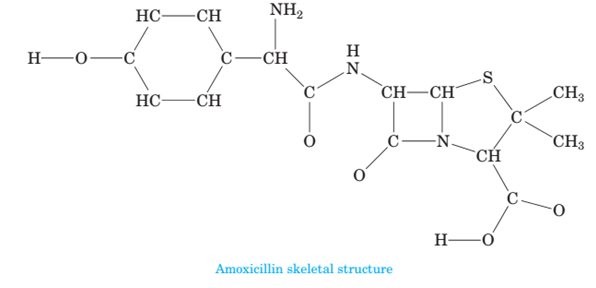
Concept explainers
3-127 Amoxicillin is an antibiotic used to treat bacterial infections caused by susceptible microorganisms. Consider the skeletal structure of amoxicillin (y refer to the structure at bottom of page). Where all the bonded atoms are shown but double bonds, triple bonds, and/or lone pairs are missing:
(a) Complete the structure of amoxicillin.
(b) Identify the various types of geometries present in each central atom using VSEPR theory
(e) Determine the various relative bond angles as sociated with each central atom using VSEPR theory.
(d) What is the most polar bond in Amoxicillin?
(e) Would you predict amoxicillin to be polar or nonpolar?
(f) Is amoxicillin expected to possess resonance? Explain why or why not.
V Chemical structure for problem 3-127

Trending nowThis is a popular solution!

Chapter 3 Solutions
Introduction to General, Organic and Biochemistry
- For each molecule, assign each stereocenter as R or S. Circle the meso compounds. Label each compound as chiral or achiral.arrow_forwardBlackboard app.aktiv.com X Organic Chemistry II Lecture (mx Aktiv Learning App Curved arrows are used to illustrate the flow of electrons. Using the provided starting and product structures, draw the curved electron-pushing arrows for the following reaction or mechanistic step(s). Be sure to account for all bond-breaking and bond-making steps. Problem 25 of 35 Select to Edit Arrows CH3CH2OK, CH3CH2OH L Gemini M 31 0:0 :0: 5x Undo Reset Done :0: Harrow_forwardI have some reactions here for which I need to predict the products. Can you help me solve them and rewrite the equations, as well as identify the type of reaction? Please explain it to me.I have some reactions here for which I need to predict the products. Can you help me solve them and rewrite the equations, as well as identify the type of reaction? Please explain it to marrow_forward
- Draw the major product of this reaction. Ignore inorganic byproducts. Problem 17 of 35 1. CH3CH2Li O H 2. Neutralizing work-up @ Atoms, Bonds and Rings Draw or tap a new boarrow_forwardWill this convert the C=O to an alcohol? Or does its participation in the carboxy group prevent that from happening?arrow_forwardI have some reactions here for which I need to predict the products. Can you help me solve them and rewrite the equations, as well as identify the type of reaction? Please explain it to me.I have some reactions here for which I need to predict the products. Can you help me solve them and rewrite the equations, as well as identify the type of reaction? Please explain it to marrow_forward
 Introduction to General, Organic and BiochemistryChemistryISBN:9781285869759Author:Frederick A. Bettelheim, William H. Brown, Mary K. Campbell, Shawn O. Farrell, Omar TorresPublisher:Cengage Learning
Introduction to General, Organic and BiochemistryChemistryISBN:9781285869759Author:Frederick A. Bettelheim, William H. Brown, Mary K. Campbell, Shawn O. Farrell, Omar TorresPublisher:Cengage Learning
